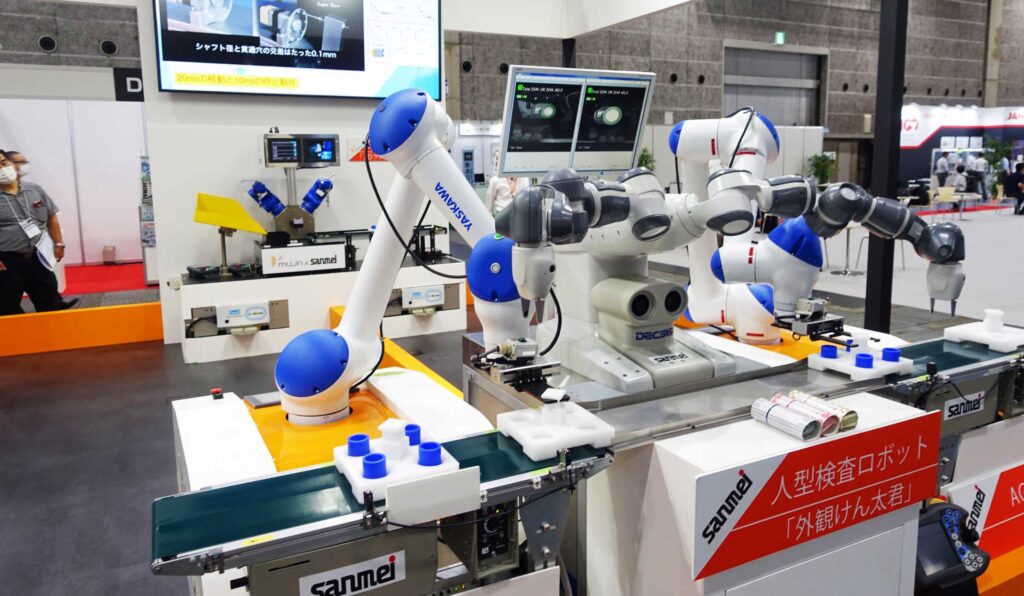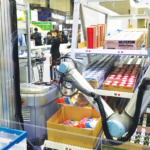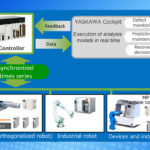ASIA ELECTRONICS INDUSTRYYOUR WINDOW TO SMART MANUFACTURING
New Robot Systems Innovate Factory Automation
Industry players highlighted the latest robot systems, automation, and labor-saving solutions in manufacturing sites in the recent 25th Manufacturing World Osaka. Particularly, the three-day event that started Oct. 6 featured the latest factory technologies, systems, and solutions.
Along with other highlights, the three-day event’s main exhibition, the Mechanical Components & Materials Technology Expo (M-Tech), showcased the latest collaborative robots and automated guided vehicles (AGVs). Over 650 companies participated in the said event held in Osaka.
Latest Solutions, Services
THK Co., Ltd. demonstrated the SIGNAS transfer robot, which autonomously moves by recognizing signposts using a built-in stereo camera. The company has been offering SIGNAS since September 2020. Along with SIGNAS, on show were robots with maximum load capacity of 150kg and travel speed of 60m/min. In addition, the company also featured models with maximum towing force of 500kg and travel speed of 30m/min.

The company touted the capabilities of the robots to move ahead, negotiate curves, spin turns, uphill travelling of slope with 5°, level difference clearing of 10mm, groove width of 50mm, and continuous transfer of eight hours.
They autonomously travel by recognizing 5m ahead using a 7.5cm-square signpost, 10m ahead using a 15cm-square signpost, and 20m ahead using a 30cm-square signpost.
Furthermore, THK also promoted its subscription service to detect abnormality from vibration waveforms read by an acceleration sensor attached to linear motion guides (LM guides). The company launched the service in Jan. 2020.
On the other hand, HIWIN Technologies Corp. exhibited a visualization system for the state of ball screws with vibration sensor. The company proposed the visualization system for predictive maintenance. Besides, it demonstrated a wafer transfer robot, which handles 2- to 12-inch wafers.
In addition, the company also introduced the efforts of Robot Technical Center to strengthen its service system in Japan using a panel. Located in Tokyo, the center commenced late last year. The company also exhibited a lineup of electric grippers.
Reinforces Robot Systems
TALK SYSTEM Co., Ltd., THK’s group company, demonstrated a profiling unit, which enables support, grip, and transfer of works of various shapes without changing chucks and jigs in a suction robot system, which can transfer up to 150kg. Furthermore, the company combined the profiling unit and an industrial robot into the suction robot system. Also, the profiling unit has multiple quick clampers arranged vertically and horizontally to fix the shaft in accordance with the unevenness of works. The company originally developed the quick clamper.
Meanwhile, the company also exhibited Flexible Adjuster, a work support unit, which enables stepless adjustment of height. TALK SYSTEM plans to begin offering the Flexible Adjuster by the end of the year as an application product of the quick clamper.

Harmonic Drive Systems Inc. introduced HarmonicDrive, a reduction gear for precision control of robots and other machines. The company also exhibited a ultralightweight and flat unit reduction gear with half the thickness of the previous product. In addition, it contributes to weight reduction of robot arms. Also on show was a high-performance gear head, which can be easily attached to a servo motor with a single touch to achieve a high-precision actuator.
Fusion of Robot Systems
Among trading companies of industrial equipment, Sanmei Co., Ltd. (Shizuoka Prefecture) demonstrated automated transfer of works set on the temporary placing table. Appearance Inspection Kenta, Sanmei’s original humanoid inspection robot, incorporates DECSYS CORPORATION’s two-dimensional (2D) camera. Meanwhile, this system goes to YuMi, ABB’s double-arm collaborative robot. Then, AGBOT, Sanmei’s original AGV robot mounted with Yaskawa Electric Co., Ltd.’s MOTOMAN-HC10 collaborative robot on S-CART, NIDEC-SHIMPO CORPORATION’s AGV, automatically transfer these works to the workpiece picking system. They consist of two MotoMINI handling six-axis articulated robots from Yaskawa Electric. MotoMINI picked up loose workpieces and set them on the temporary placing table. AGBOT automatically transferred the works set on the table to Appearance Inspection Kenta.
The company also exhibited originally developed stepping servo, made by attaching an encoder to a stepping motor to provide servo function.

DAIDO Corporation (Aichi Prefecture) provides as a cell the SW-BA automatic placement system for manual insertion components, which does not require teaching skill. It automatically inserts transformers, relays, and connectors, which normally, operators need to insert manually on printed circuit boards (PCBs) using FUJI Corporation’s SmartWing horizontal articulated robot. The company proposed the reduction of man hour for system integration.
Daiki Sangyo Co., Ltd. (Osaka Prefecture) demonstrated MiR250Hook towing-type human-collaborative autonomous mobile robot (AMR) from Mobile Industrial Robots A/S of Denmark. The company introduced actual machines of top module solutions from ROEQ of Denmark: roller solution, cart & lack solution, and lifter solution that can easily transfer works of various shapes and weights in accordance with facilities at the transfer destination by combining them with MiR’s AMR.
The company also proposed Denmark-based OnRobot A/S’s robot hands, cameras, torque sensors and other peripheral devices and accessories, which it put on the market in January, and the SVF Series vision picking feeder from Suzuno Seisakusho, K.K. (Kanagawa Prefecture), which it announced in May.
Osaka-based TATSUTA Co., Ltd. promoted an automatic PCB inspection system that can simultaneously inspect 100 items of components in five seconds. The PCB inspection system combines MOQSEE industrial image inspection camera system from Sense Things Japan Inc. (Osaka Prefecture), which eliminates omission of visual inspection and converts inspection results into data, and the MELFA ASSISTA collaborative robot from Mitsubishi Electric Corporation. The company also introduced ZNAI deep learning engine image analysis system for visual inspection of products.




